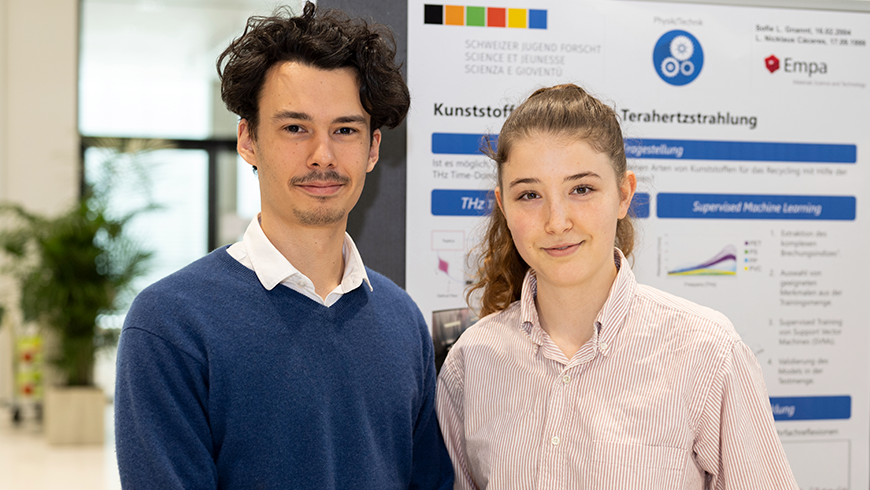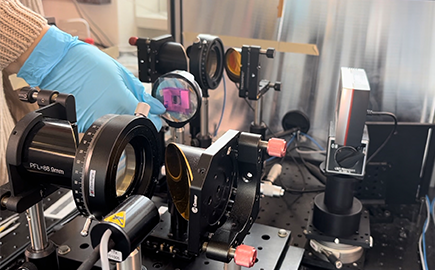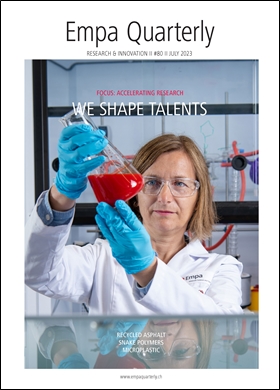Special award for Empa apprentices
Future physics technicians triumph in "Schweizer Jugend forscht" competition
An outstanding performance in the national "Schweizer Jugend forscht" competition opens up new doors. That is exactly what Sofie Gnannt and Nick Cáceres, physics lab technician apprentices at Empa's Transport at Nanoscale Interfaces Lab, have achieved. With their project "Plastic Separation with Terahertz Radiation", which was rated "outstanding", they will represent Switzerland in October at MILSET, the international young researchers' conference in Mexico.

From Uster to St. Gallen – and then to Mexico! A journey that physics lab technician apprentices Sofie Gnannt and Nick Cáceres from the fourth year of their apprenticeship embarked on in November 2022 when they won both the Jury Prize and the Participant Prize for their project "Plastic Separation with Terahertz Radiation" at the Züri-Oberland apprenticeship competition – an exhibition with 34 projects and a four-digit number of visitors.
After their success in Uster, the two went on to St. Gallen in April 2023 for the finals of the 57th National Competition of "Schweizer Jugend forscht" (SJF), where Sofie and Nick were given the opportunity to compete against youths – mainly grammar school students – from all over Switzerland. After the SJF preliminaries in January 2023 in Bern, the two were supported by an expert from SJF and were able to deepen their research. This led to a project that was presented to a jury of experts as well as to the general public – and was finally awarded the rating "outstanding" as well as the special prize MILSET Expo-Sciences International (ESI), sponsored by the Metrohm Foundation.Everyday problems – smart solutions

The focus of the two young researchers' project was on developing efficient methods for recycling plastics – a topic that is considered particularly important in the current era of reuse and recycling. This was also the motivation for Nick: "In today's world there are many problems, one of which is plastic waste pollution. This motivated us to develop a possible solution approach with our project." To achieve a reliable classification of plastics for recycling, the two apprentices investigated Terahertz Time Domain Spectroscopy (THz-TDS) as a method for extracting macromolecular information from unknown polymers, which was possible due to the relatively high transparency of plastics. This yielded important insights into how a specific polymer material interacts with Terahertz radiation. As for terahertz radiation, these are non-ionizing, electromagnetic waves - with wavelengths that lie between the microwave and infrared range. This technique was chosen for the research project because the two apprentices had been practicing it since their first year of apprenticeship and it was suitable for the experiment. Machine learning was used to train the model with data from everyday plastics to distinguish them from each other and classify them into four of the most important recyclable classes.
Success through teamwork and mentoring
The fact that research means much more than in-depth study in one field is something Sofie and Nick can confirm through their newfound experiences. It also requires perseverance, diligence and support from like-minded people. One particular challenge, for example, was compiling the written documentation and the extensive literature research it required. "This work showed us how we can combine our learned knowledge with practical work," says Sofie. In doing so, the two apprentices proceeded in a very determined and structured manner, as the SJF expert Gregory Gäumann emphasized in his acknowledgment.
Moreover, the two apprentices demonstrated with their solid approach how solutions to an existing social problem can be successfully developed and implemented. The vocational trainer of the two apprentices at Empa, Dominik Bachmann, was impressed by how independently the two had familiarized themselves with the topic, obtained relevant literature and, when they had questions, turned not only to him but also to experts within Empa. He says: "I found Sofie and Nick to be very motivated and saw how they spurred each other on to top performance through committed teamwork. I think that's what made them so successful."
Empa has a track record of being awarded the quality label "Great Start! Ausbildungsbetrieb" by the consulting firm "Great Place to Work" – and is willing to support young talents who want to make a significant commitment. Sofie and Nick's path shows: By working together, the doors are wide open!
Dominik Bachmann
Transport at Nanoscale Interfaces
Phone +41 58 765 4796
Amanda Caracas
Communication
Phone +41 58 765 60 59
amanda.caracas@empa.ch
Download high resolution images here.
Project "Plastic Separation with Terahertz Radiation"
Project video
Physics lab apprenticeship at Empa Transport at Nanoscale Interfaces Lab
Apprenticeship at Empa
Media release 23.5.2022 (German) «Eine Berufslehre an der Empa ist eine gute Wahl»

Empa Quarterly#80 Accelerating research
The young people of today are the decision-makers of tomorrow. In this issue, the focus is therefore not (only) on materials and technologies, but also on the people who make them possible: Researchers, founders, apprentices and students. Through support at all professional and academic levels, these talents can reach new heights in science or enter the Swiss economy as urgently needed skilled workers.
Read the latest EmpaQuarterly online or download the pdf-version.
-
Share






